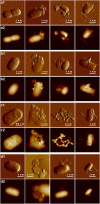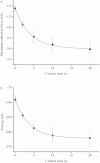Atomic force microscopy measurements of bacterial adhesion and biofilm formation onto clay-sized particles
- PMID: 26585552
- PMCID: PMC4653644
- DOI: 10.1038/srep16857
Atomic force microscopy measurements of bacterial adhesion and biofilm formation onto clay-sized particles
Abstract
Bacterial adhesion onto mineral surfaces and subsequent biofilm formation play key roles in aggregate stability, mineral weathering, and the fate of contaminants in soils. However, the mechanisms of bacteria-mineral interactions are not fully understood. Atomic force microscopy (AFM) was used to determine the adhesion forces between bacteria and goethite in water and to gain insight into the nanoscale surface morphology of the bacteria-mineral aggregates and biofilms formed on clay-sized minerals. This study yields direct evidence of a range of different association mechanisms between bacteria and minerals. All strains studied adhered predominantly to the edge surfaces of kaolinite rather than to the basal surfaces. Bacteria rarely formed aggregates with montmorillonite, but were more tightly adsorbed onto goethite surfaces. This study reports the first measured interaction force between bacteria and a clay surface, and the approach curves exhibited jump-in events with attractive forces of 97 ± 34 pN between E. coli and goethite. Bond strengthening between them occurred within 4 s to the maximum adhesion forces and energies of -3.0 ± 0.4 nN and -330 ± 43 aJ (10(-18) J), respectively. Under the conditions studied, bacteria tended to form more extensive biofilms on minerals under low rather than high nutrient conditions.
Figures






References
-
- Chenu C. & Stotzky G. Interactions between microorganisms and soil particles: an overview. In Interactions between Soil Particles and Microorganisms: Impact on the Terrestrial Ecosystem. Huang P. M., Bollag J. M. & Senesi N. (eds): John Wiley and Sons, USA pp. 3–40 (2002).
-
- Young I. M. & Crawford J. W. Interactions and self-organization in the soil-microbe complex. Science 304, 1634–1637 (2004). - PubMed
-
- Huang P. M., Wang M. K. & Chiu C. Y. Soil mineral–organic matter–microbe interactions: impacts on biogeochemical processes and biodiversity in soils. Pedobiologia 449, 609–635 (2005).
-
- Kim J., Dong H., Seabaugh J., Newell S. W. & Eberl D. D. Role of microbes in the smectite-to-illite reaction. Science 303, 830–832 (2004). - PubMed
-
- Wu H. et al. Soil colloids and minerals modulate metabolic activity of Pseudomonas putida measured using microcalorimetry. Geomicrobiol. J. 31, 590–596 (2014a).
Publication types
MeSH terms
Substances
LinkOut - more resources
Full Text Sources
Other Literature Sources
Molecular Biology Databases
Miscellaneous

